weight MERCEDES-BENZ E-CLASS CABRIOLET 2010 Owners Manual
[x] Cancel search | Manufacturer: MERCEDES-BENZ, Model Year: 2010, Model line: E-CLASS CABRIOLET, Model: MERCEDES-BENZ E-CLASS CABRIOLET 2010Pages: 333, PDF Size: 7.64 MB
Page 20 of 333

Storing
........................................... 299
Tyr esize (data) .............................. 303
Tyr etrea d...................................... 299
Tyres and wheels (important
safet yinformation) ........................... 298 U
Un laden weight ................................. 317
Un lock ing
Emergency unlocking .......................71
From insid ethe vehicle (central
unl ocking button) ............................. 70 V
Vanity mirror Sun vis or........................................ 251
Variable Speedtronic ........................170
Vehi cle
Emergency unlocking .......................71
Equ ipment ....................................... 18
Exterio rview .................................... 22
Individua lsettings (on-board com-
puter) ............................................ .204
Leaving parked up .........................154
Lowering ........................................ 284
Rais ing. .......................................... 281
To wing away .................................. 290
To w-st arting ................................... 290
Transporting .................................. 292
Vehi cled ata
se eT echnical data
Vehicle dimensions ...........................317
Vehi clee lectronics ........................... 310
Vehi clei dentification number
se eV IN
Vehi clei dentification plate ..............312
Vehi clet ool kit .................................. 274
Vehi clew eights ................................. 317
Vents seeA ir vents .................................. 130
Vide o(DV D)........................................ 200
Video DVD (on-board computer) ......200
VIN ...................................................... 312 W
Warning and indicator lamps LIM (cruise control )........................ 158
LIM (Distroni cPlus) ....................... 162
LIM (variabl eSpeedtronic) .............170
Warning triangle ................................ 273
Whee lboltt ightening torque ...........284
Whee lchock ...................................... 281
Wheels Changing/replacing ....................... 302
Ch anging awheel .......................... 280
Ch ecking ........................................ 299
Cleaning ......................................... 264
Fitting awheel ............................... 283
Guid elines to be observed .............298
Removing awheel .......................... 283
Tightening torque ...... ..................... 284
Whee lsize/tyre size ...................... 303
Win ddeflector
see AIRCAP
Wind deflector (cleaning instruc-
tions) .................................................. 266
Windowbag Display message ............................ 214
Operatio n......................................... 38
Windows
seeS ide windows
Windows (cleaning instruct ions) ..... 267
Windscre en
Demisting ...................................... 127
Windscree nwashe rfluid (display
message) ............................................ 234
Windscreen wipers Importan tsafet ynotes .................. 115
Replacing the wipe rblades ............ 116
Switch ingo n/off ........................... 116
Tro ubleshooting ............................. 117
Winte rdriving ............................ 156, 157
Winter tyres ....................................... 156
Limiting the spee d(on-board com-
puter) ............................................ .207
Wipe rblades
Cleaning ...... ................................... 267
Replacing ....................................... 116 Index
17 BA 207 ECE ÄJ 2010/1a; 1; 2, en-GB
mkalafa
Version: 3.0.2.11 2010-01-26T13:03:22+01:00-Seite 17
Page 21 of 333

Protection of th
eenvironment Notes
H
Environmental note
Daimler's declared polic yisone of integrated
environmental protection.
The objectives are for the natural resources
which form the basis of our existence on this
plane ttobeu sed sparingl yand in amanner
which takes the requirements of both nature
and humanity into account.
You too can help to protect the environment
by operating your vehicle in an environmen-
tally-responsible manner.
Fuel consumption and the rate of engine,
transmission, brake and tyre wear depend on
the following factors:
R operating conditions of your vehicle
R your personal driving style
You can influence both factors.
You shoul dbear the following in mind:
Operating conditions
R avoid short trips as these increase fuel con-
sumption.
R mak esure that the tyre pressures are
always correct.
R do not carry any unnecessary weight.
R keep an eye on the vehicle's fuel consump-
tion.
R remove roof racks once you no longer need
them.
R ar egularly serviced vehicle will contribute
to environmental protec tion. You should
therefor eadhere to the service inter vals.
R always have maintenance work carried out
at aq ualified specialist workshop ,e.g. a
Mercedes-Benz Service Centre.
Personal driving style
R do not depress the accelerator pedal when
starti ngthe engine.
R do not warm up the engine with the vehicle
stationary. R
drive carefully and maintain asafe distance
from the vehicle in front.
R avoid frequent, sudden acceleration.
R change gear in good time and use each gear
only up to 2
/ 3 of its maximum engine
speed.
R switch off the engine in stationary traffic. Returning used vehicles
Mercedes-Benz will take back your
Mercedes-Benz to dispose of it in an environ-
mentally responsible manner, in accordance
with the European Union (EU) End of Life
Vehicles Directive.
The End of Life Vehicles Directive applies to
vehicles of up to 3.5 tgros svehicle weight, in
accordance with national regulations. For
sever alyears, Mercedes-Benz has been
meeting all the lega lrequirements for a
design which allows for recycling and reuse.
There is anetwor kofreturnpoint sand dis-
ass embly plants which can recycle your vehi-
cle in an environmentally-responsibl eman-
ner. The options for recyclin gvehicles and
part sare constantly being developed and
improved. This means that your Mercedes-
Benz will als ocontinue to meet even the
inc reased recyclin gquotas in the future in
good time. You can obtain further information
from your national Mercedes -Ben zh omepage
or your national hotlin enumber. Vehicle equipment
This manual describes all the standard and
optional equipment of your vehicle available
at the time of publication of the Owner's Man-
ual. Country-specific differences are possi-
ble. Bear in mind that your vehicle may not
feature all functions described here. This also
refers to safety-related systems and func-
tions. The equipment in your vehicle may
therefor ediffer from that shown in the
description sand illustrations .All the systems 18
Introduction BA 20
7ECE ÄJ 2010 /1a; 1; 2, en-GB
mkalafa Version: 3.0.2.11 2010-01-26T13:03:22+01:00 -Seite 18
Page 47 of 333
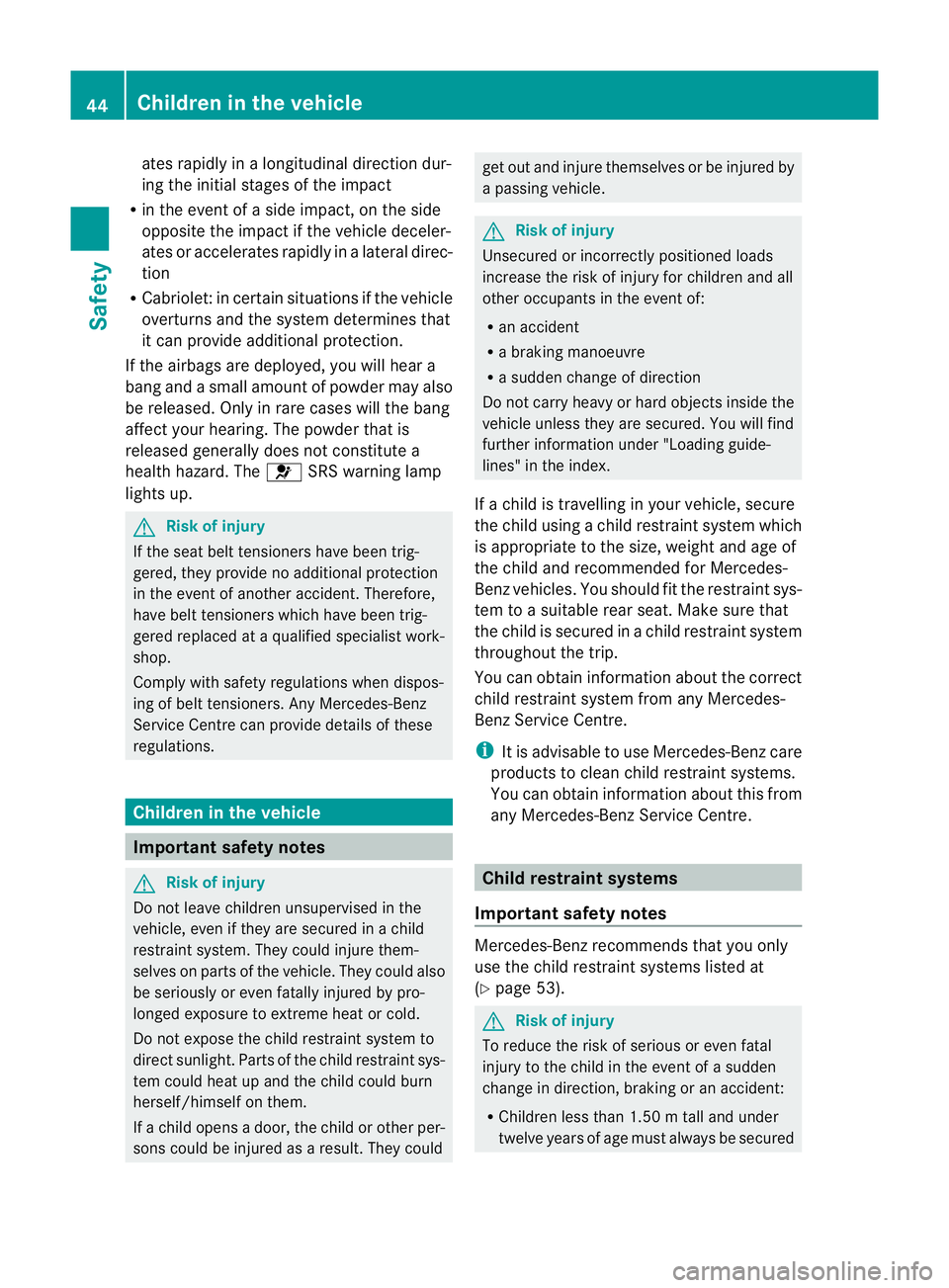
ates rapidly in
alongitudinal dir ectiondur-
ing the initial stages of the impact
R in the even tofaside impact, on th eside
opposit ethe im pactift he vehicle deceler-
ates or accelerates rapidly in alateral direc-
tion
R Cabriolet: in certain situations if the vehicle
overturns and the system determines that
it can provide additional protection.
If the airbags are deplo yed,you will hear a
bang and asmall amount of powder may also
be released. Only in rare cases will th ebang
affect your hearing. The powde rthat is
released generally does not constitute a
healt hhazard. The 6SRS warning lamp
lights up. G
Risk of injury
If the seat belt tensioners have been trig-
gered, they provide no additional protection
in the event of another accident. Therefore,
have belt tensioners which have been trig-
gered replaced at aqualified specialist work-
shop.
Comply with safety regulations when dispos-
ing of belt tensione rs.A ny Mercedes-Be nz
Service Centre can provid edetails of these
regulations. Children in the vehicle
Impor
tantsafety notes G
Ris
kofi njury
Do not leav echildren unsupervised in the
vehicle, even if they ar esecured in achild
restraint system .They coul dinjure them-
selves on parts of the vehicle. The ycould also
be seriously or even fatally injure dbypro-
longe dexposure to extreme hea torcold.
Do not expose the child restraint system to
direct sunlight. Part softhe chil drestraint sys-
tem could heat up and the child could burn
herself/himself on them.
If ac hild opens adoor, the child or other per-
sons coul dbeinjured as aresult. They could get out and injure themselves or be injured by
ap
assing vehicle. G
Risk of injury
Unsecured or incorrectly positioned loads
increase the risk of injury for children and all
other occupants in the event of:
R an accident
R ab raking manoeuvre
R as udden change of direction
Do not carry heavy or hard objects inside the
vehicle unless they are secured. You will find
further information under "Loading guide-
lines" in the index.
If ac hild is travellin ginyour vehicle, secure
the child using achild restraint system which
is appropriate to the size, weight and age of
the chil dand recommended for Mercedes-
Benz vehicles. You should fit the restraint sys-
tem to asuitable rear seat. Make sure that
the child is secured in achild restraint system
throughout the trip.
You can obtai ninformation abou tthe correct
chil drestraint system from any Mercedes-
Benz Servic eCentre.
i It is advisable to use Mercedes-Ben zcare
product stocleanc hildr estraint systems.
You can obtain informatio nabout this from
any Mercedes-Benz Ser vice Centre. Chil
drestraint systems
Importan tsafety notes Mercedes-Benz reco
mmends that you only
use the child restraint system slisted at
(Y page 53). G
Risk of injury
To reduce the risk of serious or even fatal
injury to the child in the event of asudden
change in direction, brakin goranaccident:
R Children less than 1.5 0mtall and under
twelv eyears of age must alway sbesecured 44
Children in th
evehicleSafety
BA 20 7ECE ÄJ 2010/1a; 1; 2, en-GB
mkalafa Version: 3.0.2.11 2010-01-26T13:03:22+01:00-Seite 44
Page 54 of 333
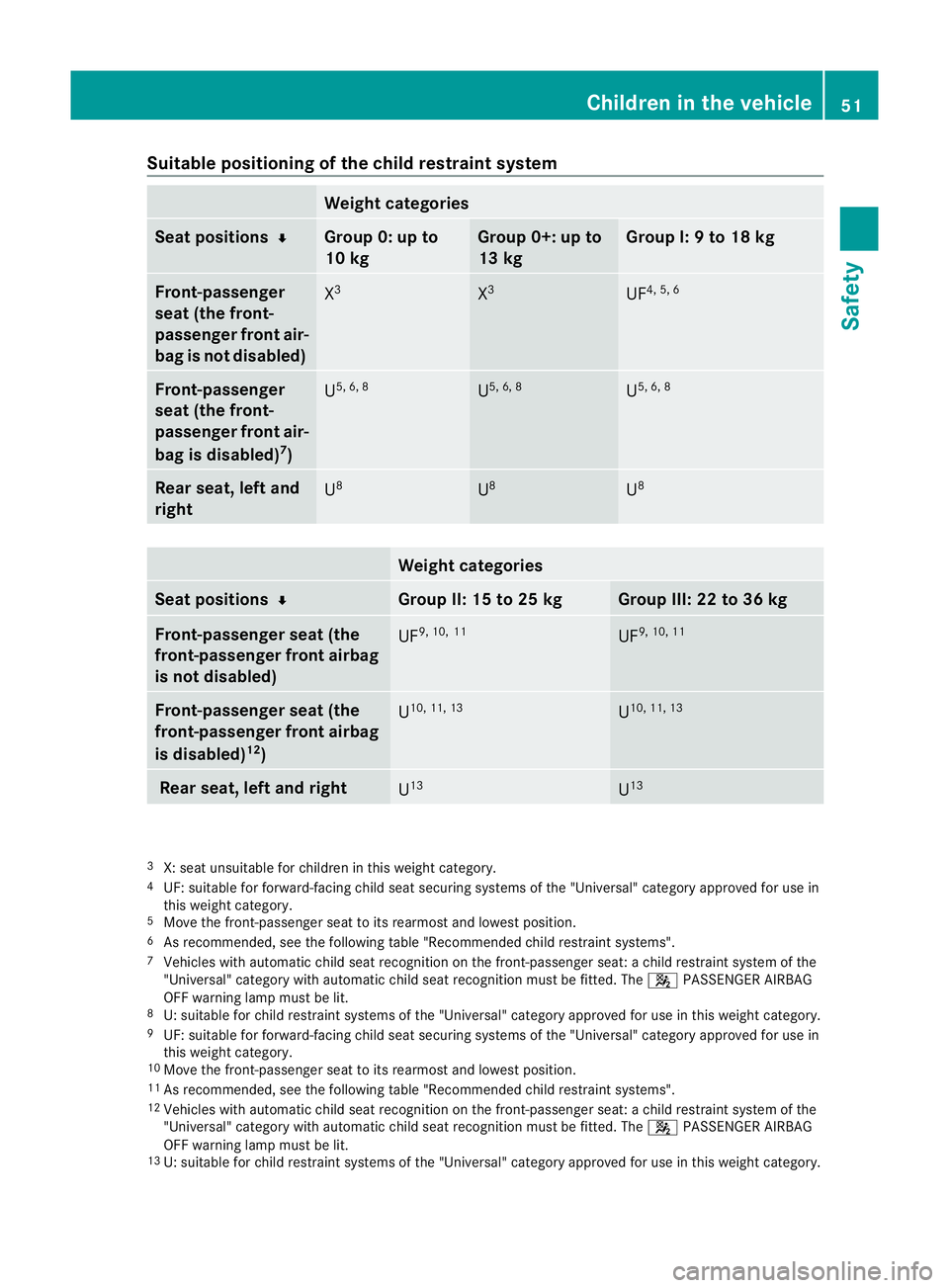
Suitabl
epositioning of the child restraint system Weight categories
Seat positions
¬ Grou
p0:upto
10 kg Group 0+: up to
13 kg Group I:
9to18kg Front-passenger
seat (the front-
passenger front air-
bag is not disabled)
X
3 X
3 UF
4, 5, 6 Front-passenger
seat (the front-
passenger front air-
bag is disabled)
7
) U
5, 6, 8 U
5, 6, 8 U
5, 6, 8 Rear seat, left and
right
U
8 U
8 U
8 Weight categories
Seat positions
¬ Group II: 15 to 25 kg Group III
:22to36kg Front-passenger seat (the
front-passenger front airbag
is not disabled)
UF
9, 10, 11 UF
9, 10, 11 Front-passenger seat (the
front-passenger front airbag
is disabled)
12
) U
10, 11, 13 U
10, 11, 13 Rear seat, left and right
U
13 U
13 3
X: seat unsuitable for children in this weight category.
4 UF: suitable for forward-facin gchild seat securing system softhe "Universal" category approved for use in
this weight category.
5 Move the front-passenger seat to its rearmost and lowest position.
6 As recommended, see the following table "Recommended child restraint systems".
7 Vehicles with automatic child seat recognition on the front-passenger seat: achild restraint system of the
"Universal "category with automatic child seat recognition must be fitted. The 4PASSENGER AIRBAG
OFF warning lamp must be lit.
8 U: suitable for child restraint systems of the "Universal" category approved for use in this weight category.
9 UF: suitable for forward-facing child seat securing systems of the "Universal" category approved for use in
this weight category.
10 Move the front-passenger seat to its rearmost and lowest position.
11 As recommended, see the following table "Recommended child restraint systems".
12 Vehicles with automatic child seat recognition on the front-passenger seat: achild restraint system of the
"Universal "category with automatic child seat recognition must be fitted. The 4PASSENGER AIRBAG
OFF warning lamp must be lit.
13 U: suitable for child restraint systems of the "Universal" category approved for use in this weight category. Childre
ninthe vehic le
51Safety
BA 207ECE ÄJ 2010 /1a; 1; 2, en-GB
mkalafa Version: 3.0.2.11 2010-01-26T13:03:22+01:00 -Seite 51 Z
Page 55 of 333

"Universal" category child restraint systems can be recognised by their orange approval label.
Approval label on the child restraint system (example)
Suitable seat positions for ISOFIX child seat securing systems
Weight categories
Carry-cot 0: up to
10 kg 0+: up to 13 kg
Size cate-
gory F G E E D C
Equipment ISO/L1 ISO/L2 ISO/R1 ISO/R1 ISO/R2 ISO/R3
Rear seat,
left and right
X
14 X
14 IL
15 IL
15 IL
15 IL
15 Weight category
I:
9to18kg Size category D C B B1 A
Equipment ISO/R2 ISO/R3 ISO/F2 ISO/F2X ISO/F3
Rear seat, left
and right
IL
16 IL
16 IUF
17 IUF
17 IUF
17 14
X: this position is unsuitable.
15 IL: as recommended ,see the following table of "Recommended ISOFIX child seat securing systems".
16 IL:a sr ecommended, see the following table of "Recommended ISOFIX child seat securing systems".
17 IUF: suitable for forward-facing ISOFIX child seat securing systems that belong to the "Universal" category
and are approved for use in this weight category. 52
Children in the vehicleSafety
BA 20
7ECE ÄJ 2010/1a; 1; 2, en-GB
mkalafa Version: 3.0.2.11
2010-01-26T13:03:22+01:00
-Seite 52
Page 56 of 333
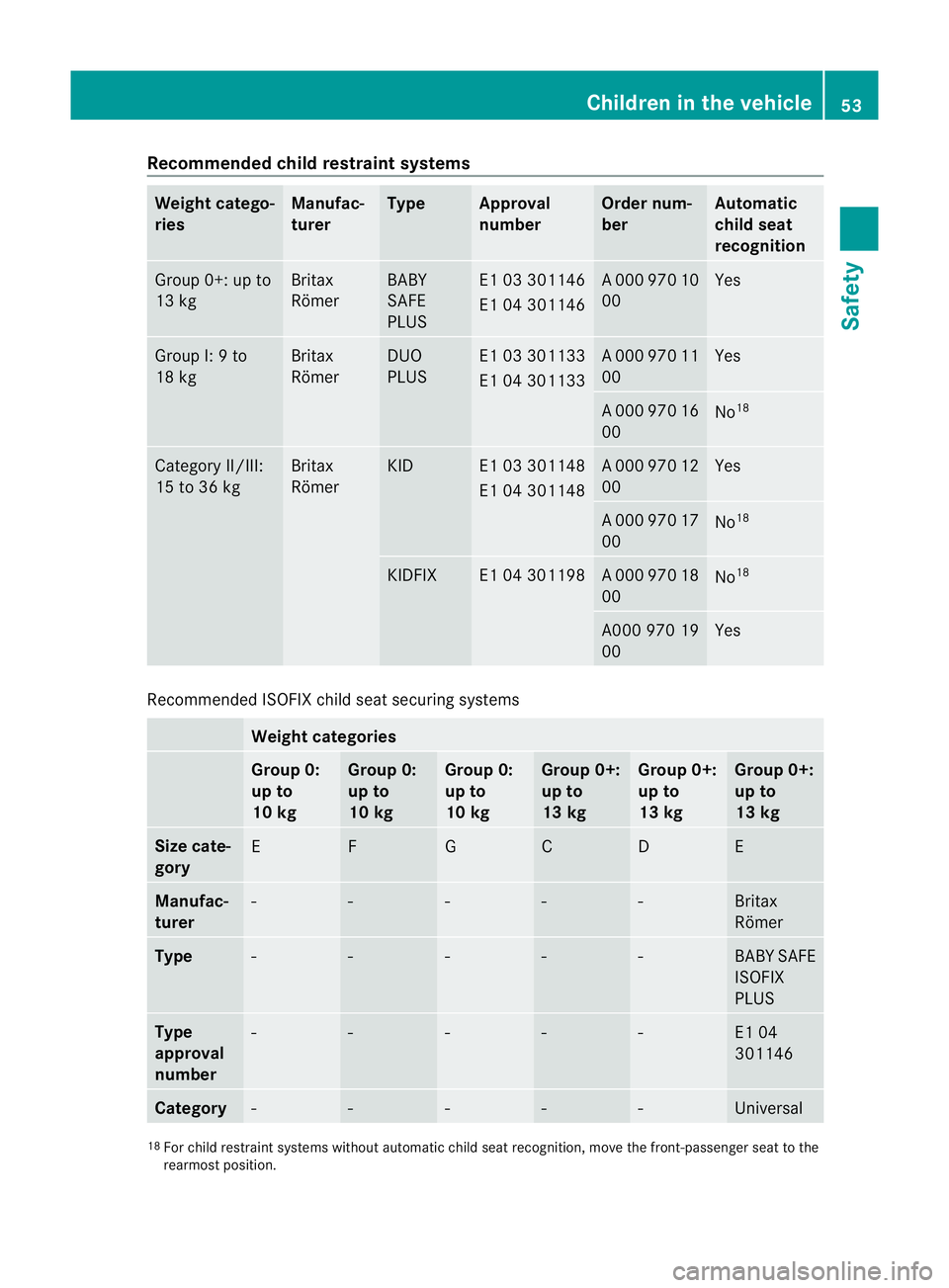
Recommende
dchild restraint systems Weight catego-
ries Manufac-
turer Type Approval
number Ord
er nu m-
ber Automatic
child seat
recognition
Group 0+: up to
13 kg Britax
Römer BABY
SAFE
PLUS E1 03 301146
E1 04 301146 A0
00 970 10
00 Yes
Group I:
9to
18 kg Britax
Römer DUO
PLUS E1 03 301133
E1 04 301133 A0
00 970 11
00 Yes
A0
00 970 16
00 No
18 Categ
oryI I/III:
15 to 36 kg Brit
ax
Römer KID E1 03 301148
E1 04 301148 A0
00 970 12
00 Yes
A0
00 970 17
00 No
18 KIDFIX E1 04 301198 A0
00 970 18
00 No
18 A000 970 19
00 Yes
Recommende
dISOFIX child se at securing systems Weight categories
Group 0:
up to
10 kg Group 0:
up to
10 kg Group 0:
up to
10 kg Group 0+:
up to
13 kg Group 0+:
up to
13 kg Group 0+:
up to
13 kg
Size cate-
gory
E F G C D E
Manufac-
turer
- - - - - Britax
Römer
Type
- - - - - BABY SAFE
ISOFIX
PLUS
Type
approval
number
- - - - - E1 04
301146
Category
- - - - - Universal
18
For child restraint systems without automati cchild seat recognition ,move the front-passenger seat to the
rearmost position. Children in th
evehicle
53Safety
BA 207ECE ÄJ 2010/1a; 1; 2, en-GB
mkalafa Version:3.0.2.11
2010-01-26T13:03:22+01:0
0-Seite 53 Z
Page 190 of 333
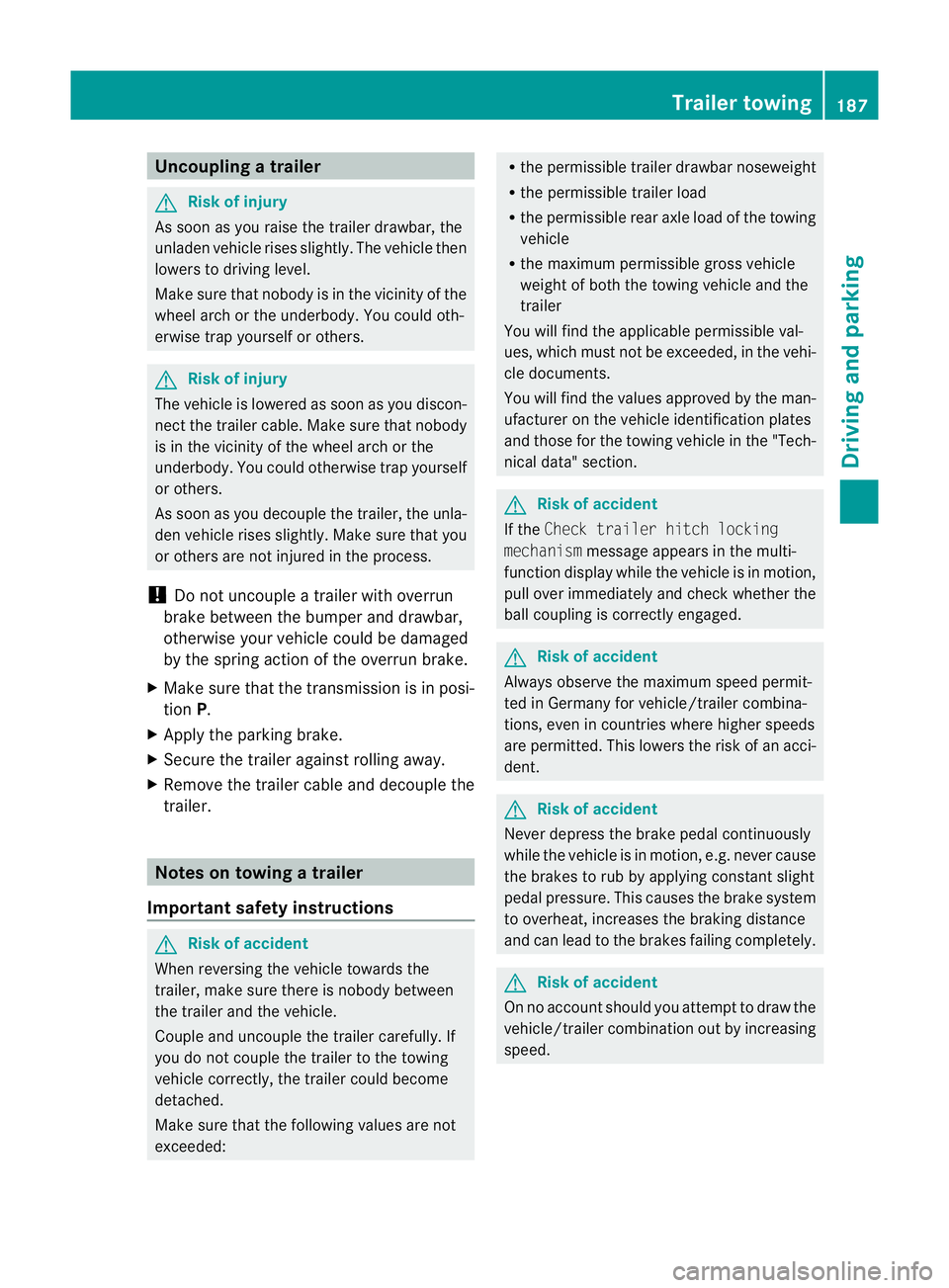
Uncoupling
atrailer G
Ris
kofi njury
As soon as yo uraise the trailer drawbar, the
unladen vehicl erises slightly .The vehicl ethen
lowers to driving level.
Make sure that nobody is in the vicinity of the
wheel arch or the underbody. You coul doth-
erwise trap yoursel forothers. G
Risk of injury
The vehicle is lowered as soo nasyou discon-
nec tthe trailer cable. Make sur ethat nobody
is in the vicinit yofthe wheel arch or the
underbody. You coul dotherwis etrap yourself
or others.
As soon as you decoupl ethe trailer ,the unla-
den vehicle rise sslightly. Make sure that you
or others are not injured in the process.
! Do not uncouple atrailer wit hoverrun
brake between th ebumper and drawbar,
otherwis eyour vehicle coul dbedamaged
by the spring action of the overrun brake.
X Make sure that the transmission is in posi-
tion P.
X Apply the parking brake.
X Secure the trailer against rolling away.
X Remove the trailer cable and decouple the
trailer. Notes on towing
atrailer
Important safety instructions G
Ris
kofa ccident
When reversing the vehicle towards the
trailer, mak esure there is nobody between
the trailer and the vehicle.
Couple and uncouple the trailer carefully. If
you do not couple the trailer to the towing
vehicle correctly, the trailer could become
detached.
Make sure that the following values are not
exceeded: R
the permissible trailer drawbar noseweight
R the permissible trailer load
R the permissible rear axle load of the towing
vehicle
R the maximu mpermissible gross vehicle
weight of both the towing vehicle and the
trailer
You will fin dthe applicable permissible val-
ues, whic hmust not be exceeded ,inthe vehi-
cle documen ts.
You will find the values approved by the man-
ufacturer on the vehicle identification plates
and those for the towing vehicle in the "Tech-
nical data" section. G
Risk of accident
If the Checktrailer hitch locking
mechanism message appears in th emulti-
function display while the vehicle is in motion,
pull over immediately and check whethe rthe
ball coupling is correctly engaged. G
Risk of accident
Always observ ethe maximum speed permit-
ted in Germany for vehicle/ trailer combina-
tions, even in countries where higher speeds
are permitted. This lowers the risk of an acci-
dent. G
Risk of accident
Never depress the brake pedal continuously
while the vehicle is in motion ,e.g. never cause
the brakes to rub by appl yingc onstant slight
pedal pressure. This causes the brake system
to overheat, increases the brakin gdistance
and can lead to the brakes failing completely. G
Risk of accident
On no account should you attempt to draw the
vehicle/trailer combination out by increasing
speed. Trailer towing
187Driving and parking
BA 207 ECE ÄJ 2010/1a; 1; 2, en-GB
mkalafa Version: 3.0.2.11
2010-01-26T13:03:22+01:00
-Seite 187 Z
Page 191 of 333
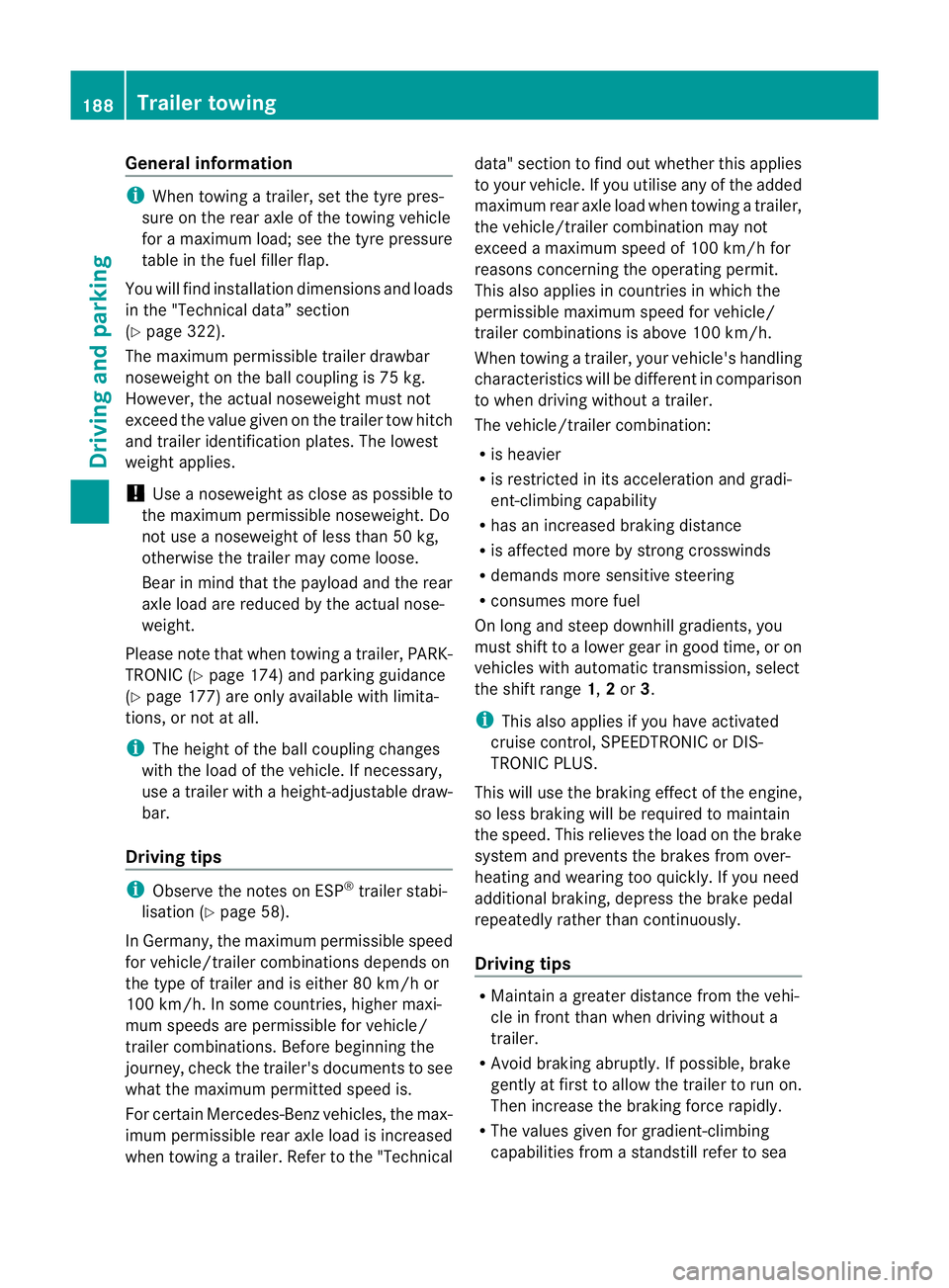
Gen
eral information i
When towing atrail er,s et the tyr epres-
sure on th erear axle of the towing vehicle
for am aximum load; se ethe tyr epressure
table in th efuel filler flap.
You will find installatio ndimensions and loads
in the "Technical data” section
(Y page 322).
The maximum permissible trailer drawbar
noseweight on the ball coupling is 75 kg.
However ,the actual noseweight must not
exceed the value given on the trailer tow hitch
and trailer identification plates. The lowest
weight applies.
! Use anoseweight as close as possible to
the maximum permissible noseweight .Do
not use anoseweight of less than 50 kg,
otherwise the trailer ma ycome loose.
Bear in min dthat the payload and the rear
axl eload ar ereduced by the actual nose-
weight.
Please not ethat when towing atrailer, PARK-
TRONIC (Y page 174) and parkin gguidance
(Y page 177 )are onl yavail ablew ith limita-
tions, or not at all.
i The height of the ball coupling changes
with the load of the vehicle. If necessary,
use atrailer wit haheight-adjustable draw-
bar.
Driving tips i
Observ ethe notes on ESP ®
trailer stabi-
lisation (Y page 58).
In Germany, the maximum permissible speed
for vehicle/ trailer combinations depends on
the type of trailer and is either 80 km/ hor
100 km/h. In some countries ,higher maxi-
mum speeds are permissible for vehicle/
trailer combinations. Befor ebeginnin gthe
journey ,check the trailer's documen tsto see
what the maximum permitted speed is.
For certain Mercedes-Benz vehicles, the max-
imum permissible rear axle load is increased
when towing atrailer. Refer to th e"Technical data
"section to fin dout whether this applies
to your vehicle. If you utilise any of the added
maximum rear axle load when towing atrailer,
th ev ehicle/ trailer combination may not
exceed amaximum spee dof100 km/h for
reasons concerning the operating permit.
This als oapplies in countries in which the
permissible maximum speed for vehicle/
trailer combinations is above 10 0km/h.
When towing atrailer, your vehicle's handling
characteristics wil lbedifferent in comparison
to when drivin gwithout atrailer.
Th ev ehicle/ trailer combination:
R is heavier
R is restricted in its acceleration and gradi-
ent-climbin gcapability
R has an increased braking distance
R is affected more by stron gcrosswinds
R demand smore sensitive steering
R consume smore fuel
On long and steep downhil lgradients ,you
must shift to alower gear in good time, or on
vehicles with automatic transmission ,select
the shift range 1,2or 3.
i This also applies if you have activated
cruise control, SPEEDTRONIC or DI S-
TRONIC PLUS.
This will use the brakin geffect of th eengine,
so les sbraking wil lberequired to maintain
the speed. This relieves the load on the brake
system and prevent sthe brakes from over-
heating and wearing too quickly .Ifyou need
additional braking, depress the brake pedal
repeatedly rather than con tinuously.
Driving tips R
Maintain agreater distance from th evehi-
cle in front than when driving without a
trailer.
R Avoid braking abruptly. If possible, brake
gently at first to allow the trailer to run on.
Then increase the braking force rapidly.
R The values given for gradient-climbing
capabilities from astandstill refer to sea 188
Trailer towingDrivin
gand pa rking
BA 20 7ECE ÄJ 2010 /1a; 1; 2, en-GB
mkalafa Version: 3.0.2.11 2010-01-26T13:03:22+01:00 -Seite 188
Page 247 of 333

Vehicl
eequipment
i Thismanua ldesc ribe sallthe standard
and optional equipment of your vehicle
which wa savailable at th etime of pur-
chase. Countr y-specif ic differences are
possible. Bear in mind tha tyour vehicle
ma ynot featur eall function sdescribed
here. Loading guidelines (Coupé)
G
Risk of inju
ry
Secure and positio nthe load as described in
the loadin gguidelines.
Otherwise, vehicle occupant scould
be injured by the load being thr own around in
the even tofsharpbraking, asudden change
in direction or an accident.
You will find further information in the "Secur-
ing aload" section.
Even if you follow all the loadin gguidelines,
the load will increase the risk of injur yinthe
even tofa naccide nt. G
Risk of poisoning
Keep the boo tlid closed while the vehicle is
in operation .Otherwi se,y ou could be pois-
one dbye xhaust fumes enterin gthe vehicle.
Th eh andling character istics of aladen vehi-
cl ea re dependent on the distributio nofthe
load withi nthe vehicle. For this reason, you
should observe the followin gnotes when
transpor ting aload:
R When transpor ting aload, never exceed the
maximum permissible gross vehicle weight
or the permissible axle loads for the vehicle
(includin goccupants).
R Position heavy loads as far forward saspos-
sible and as low down in the boot as pos-
sible.
R The load must not protrude abov ethe
upper edge of the seat backrests. R
always plac ethe load against the rea ror
front seat backrests .Make sure that the
seat backrests are securely locked into
place.
R Always place the load behind unoccupied
seats if possible.
R Secure the load with sufficiently stron gand
wear-resistant lashing material. Pad sharp
edges for protection.
i Load restraints are available at any quali-
fied specialis tworkshop, e.g. aMercedes-
Benz Servic eCentre. Stowage compartments
Important safety notes
G
Risk of injury
The stowage compartments must be closed
when item sare store dinthem. Luggage nets
ar en ot designed to secur eheavy item sof
luggage.
You or other vehicle occupant scould be
injure dbyo bjectsbeing thrown around if you:
R brak esharply
R change direction suddenly
R arei nvolved in an accident
Sharp-edge dand fragile object smust not be
placed in the luggag enet.
Do not place hard object sinthe ma ppockets.
Object smust not protrude from the map
pockets. Front stowage compartments
Glove compartment i
Depending on the vehicle equipment, an
AUX IN connection or aMedia In terface is
installed in the glove compartment. A
Media Interface is auniversal interface for
mobil eaudi od evices, such as iPods ®
or
US Bd evices; see the separate Audio or
COMAN DAPS operating instructions. 244
Stowage compa
rtmentsLoading, stowing and features
BA 207ECE ÄJ 2010 /1a;1;2,e n-GB
mkalafa Version: 3.0.2.11 2010-01-26T13:03:22+01:00-Seite 244
Page 249 of 333
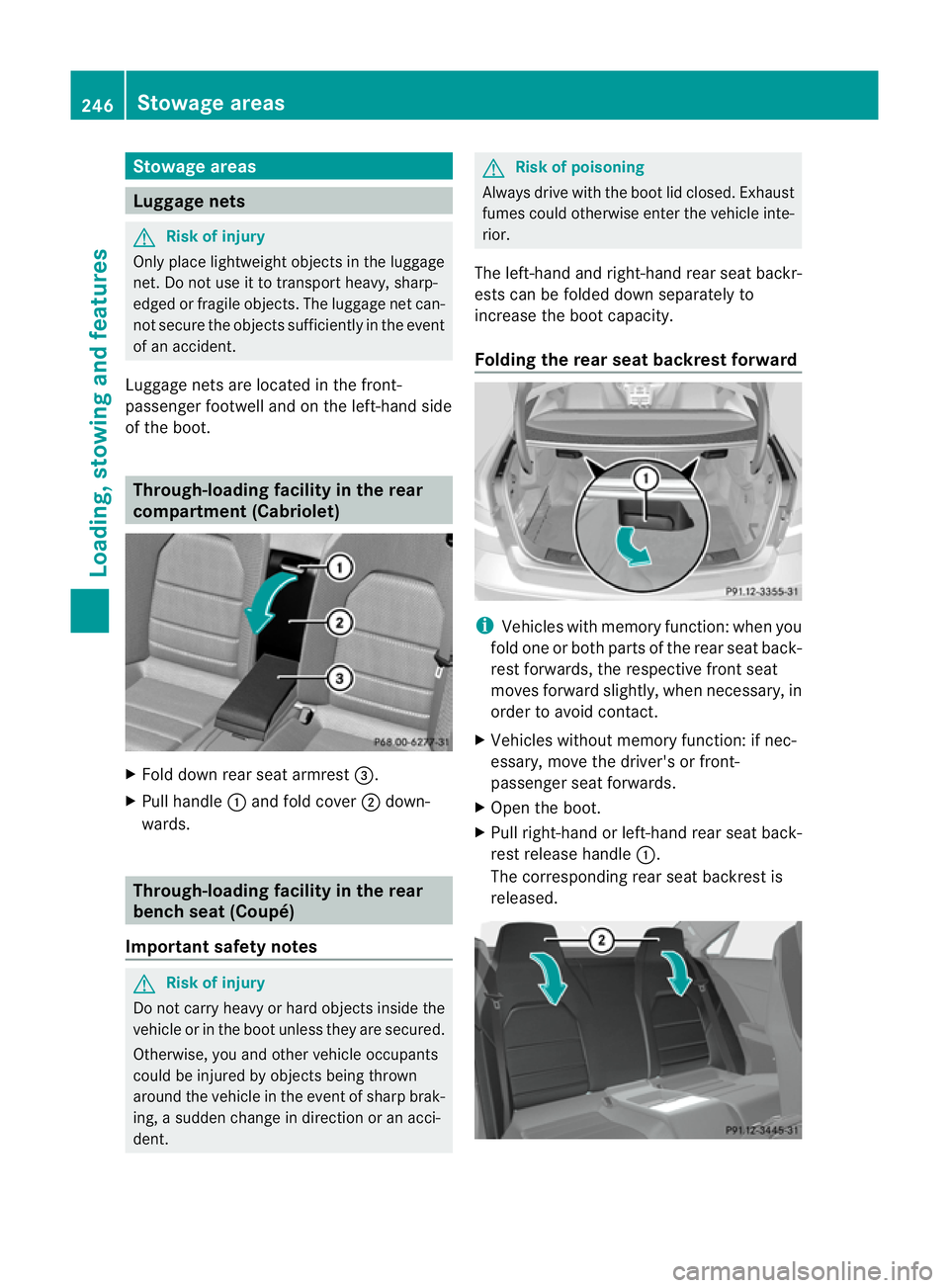
Stowage areas
Luggage nets
G
Ris
kofi njury
Only place lightweight object sinthe luggage
net .Don ot use it to transpor theavy ,sharp-
edged or fragile objec ts.T he luggage net can-
not secur ethe objec tssufficiently in the event
of an accident.
Luggage net sare locate dinthe front-
passenger footwell and on the left-hand side
of the boot. Th
rough- loading facility in the rear
compartment (Cabriolet) X
Fold down rear seat armrest =.
X Pull handle :and fold cover ;down-
wards. Through-loading facility in the rear
bench seat (Coupé)
Impor tantsafety notes G
Ris
kofi njury
Do not carry heavy or hard object sinsid ethe
vehicle or in the boot unless they ar esecured.
Otherwise, you and other vehicle occupants
could be injured by object sbeing thrown
around the vehicle in the event of sharp brak-
ing, asudden change in direction or an acci-
dent. G
Risk of poisoning
Always drive with the boot lid closed .Exhaust
fumes could otherwise enter the vehicle inte-
rior.
The left-hand and right-hand rear seat backr-
ests can be folded down separately to
increase the boot capacity.
Folding the rear seat backrest forward i
Vehicles with memory function: when you
fold one or both parts of the rear seat back-
rest forwards, the respective front seat
moves forwar dslightly, when necessary, in
order to avoid contact.
X Vehicles without memor yfunction: if nec-
essary, move the driver' sorfront-
passenger seat forwards.
X Open th eboot.
X Pull right-han dorleft-hand rear seat back-
rest release handle :.
The corresponding rear seat backrest is
released. 246
Stowage areasLoading, stowing and features
BA 20
7ECE ÄJ 2010 /1a;1;2,e n-GB
mkalafa Version: 3.0.2.11 2010-01-26T13:03:22+01:00-Seite 246